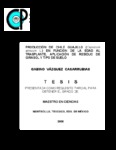Producción de chile guajillo (Capsicum annuum L.) en función de la edad al trasplante, aplicación de residuo de girasol y tipo de suelo
Abstract
En relación a la siembra directa el trasplante en el cultivo de chile permite el uso eficiente de semillas,
uniformidad en la población y seguridad en la producción. Sin embargo, dicha producción dependerá
de la edad de la plántula al trasplante. El objetivo del presente estudio fue evaluar el crecimiento y
rendimiento de dos cultivares de chile Guajillo (Capsicum annuum L.) Apaxtleco y Mirasol en función
de la edad al trasplante, el manuscrito se presenta en 4 capítulos: Capítulo I. Crecimiento y
rendimiento de chile guajillo Apaxtleco y Mirasol en función de la edad al trasplante bajo condiciones
de invernadero, en donde se establecieron 3 fechas de trasplante a los 15, 30 y 45 días después de la
emergencia (dde). Capítulo II. Crecimiento y rendimiento de chile guajillo cv Apaxtleco en función de
la edad al trasplante y la aplicación de residuo de girasol bajo condiciones de campo a los 15, 25, 35 y
45 dde. Capítulo III. Control de maleza en chile guajillo cv Apaxtleco con residuo de girasol
(Helianthus annuus L.) y Capítulo IV. Crecimiento y rendimiento de chile guajillo cv Apaxtleco, en
dos tipos de suelo en invernadero. Los resultados indican que el mayor rendimiento en cultivar
Apaxtleco y Mirasol bajo condiciones de invernadero se encontró con el trasplante a los 45 y 30 dde
(44.3 y 41.4 g respectivamente), relacionándose con una mayor altura de planta, ramas, nudos, frutos,
área foliar, el peso de la materia seca (MS) del tallo. Bajo condiciones de campo el mayor rendimiento
se logró en el cultivar Apaxtleco con trasplante a los 15 dde (1016.09 kg ha-1), que se relacionó con
mayor producción de biomasa, índice de cosecha, número de frutos por m2, nudos, ramas, área foliar,
botones y flores. Por otra parte, la incorporación de receptáculo de girasol controló la maleza sin
afectar la producción del cultivo. Así mismo, el chile Apaxtleco cultivado en suelo alcalino presentó
limitaciones en el crecimiento y rendimiento. Estos resultados sugieren que la edad al trasplante en el
cultivo de chile guajillo es determinante en el crecimiento y rendimiento; y que la respuesta al
trasplante depende del cultivar utilizado y de las condiciones en que se desarrolle el cultivo. Así
mismo, que el uso de cobertera de girasol es apropiado para el control de maleza del cultivo, puesto
que no afecta la producción._______In relation to direct seedtime the transplant in the culture of pepper allows the efficient use of seeds,
uniformity in the population and security in the production. Nevertheless, this production will depend
on the age of seedling to the transplant. The objective of the present study was to evaluate the growth
and yield of two cv of guajillo pepper (Capsicum annuum L.) Apaxtleco and Mirasol based on the age
to the transplant, the manuscript appears in 4 chapters: Chapter I. Growth and yield of guajillo pepper
Apaxtleco and Mirasol based on the age to the transplant under conditions of greenhouse, in where 3
dates of transplant to the 15, 30 and 45 days after the emergency (dde). Chapter II. Growth and yield of
guajillo pepper cv Apaxtleco based on the age to the transplant and the application of remainder of
sunflower under conditions from field to the 15, 25, 35 and 45 dde. Chapter III. Control of weeds in
guajillo pepper cv Apaxtleco with sunflower remainder (Helianthus annuus L.) and Chapter IV.
Growth and yield of guajillo pepper cv Apaxtleco, in two types of ground in greenhouse. The results
indicate that the greater yield in cv Apaxtleco and Mirasol under conditions of greenhouse was with
the transplant to 30 and 45dde (44,3 and 41,4 g respectively), being related to a greater height of plant,
branches, knots, fruits, leaf area, the weight of the dry matter (MS) of the stem. Under conditions of
field the greater yield was obtained in cv Apaxtleco with transplant to the 15 dde (1016,09 kg has-1),
that was related to greater production of biomass, index of harvest, number of fruits by m2, knots,
branches, leaf area, bellboys and flowers. On the other hand, the incorporation of residues of sunflower
controlled the weeds without affecting the production of the crop. Also, guajillo pepper cv. Apaxtleco
cultivated on alkaline ground presented limitations in the growth and yield. These results suggest that
age at transplant in the crop of guajillo pepper is determining in the growth and yield; and that the
answer to the transplant depends on used cultivar and of the conditions in which the crop is develops.
Also, that the use of sunflower cover is appropriate for the control of weeds in the crop, since it does
not affect the production.
Collections
- Tesis MC, MT, MP y DC [182]

